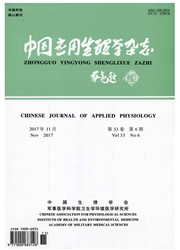

 中文摘要:
中文摘要:
目的:探讨藏羚羊骨骼肌对低氧环境的适应机制。方法:以生活在同海拔高度(4 300 m)的藏绵羊和低海拔绵羊(1 800 m)为对照,用分光光度法测定三种动物骨骼肌中肌红蛋白(Mb)含量、乳酸(LA)含量,酶活力法测定三种动物骨骼肌中乳酸脱氢酶(LDH)和苹果酸脱氢酶(MDH)活力。结果:藏羚羊骨骼肌中Mb含量明显高于藏绵羊和低海拔绵羊(P〈0.05),而藏绵羊和低海拔绵羊间无明显差异。LA含量和LDH活力明显低于藏绵羊和低海拔绵羊(P〈0.05),而MDH活力及MDH/LDH比值显著高于藏绵羊和低海拔绵羊(P〈0.05),藏绵羊和低海拔绵羊间无明显差异。结论:藏羚羊可能通过增加骨骼肌中Mb的含量,提高其在低氧环境获取氧的能力,且藏羚羊骨骼肌组织中有氧代谢比例高,这可能与肌肉中Mb含量较高有关,推测藏羚羊较高的Mb含量可能是其适应高原缺氧条件的分子基础之一。
 英文摘要:
英文摘要:
Objective: To explore the adaptive mechanism to hypoxia in skeletal muscle of tibetan antelope.Methods: Tibetan sheep which living at the same altitude(4 300 m) with tibetan antelope and low altitude(1 800 m) sheep as control, the content of myoglobin(Mb) and lactic acid(LA),the activity of lactate dehydrogenase(LDH) and malate dehydrogenase(MDH) in skeletal muscles among three animals were analyzed by spectrophotometer.Results: The content of myoglobin in skeletal muscle of tibetan antelope significantly higher than that of tibetan sheep and low altitude sheep(P0.05).And the content of LA in skeletal muscle of tibetan antelope significantly lower than that of tibetan sheep and low altitude sheep(P0.05),activity of LDH and MDH in skeletal muscle was significantly lower and higher respectively than that of tibetan sheep and low altitude sheep(P0.05).There was no significant difference between tibetan sheep and low altitude sheep.Conclusion: Tibetan antelope may improve their ability to get oxygen under hypoxia by increasing the content of myoglobin in skeletal muscle,and the proportion of aerobic metabolism is high in skeletal muscle,it may be relate that with high myoglobin content in skeletal muscle,we suppose that high myoglobin content in skeletal muscle of tibetan antelope might be one of the molecular basis to adapt hypoxia.
 同期刊论文项目
同期刊论文项目
 同项目期刊论文
同项目期刊论文
 期刊信息
期刊信息
